Much of the information on this page, as well as documentation for it, can be found in the AFSC resources “Freedom of Movement” and “Restricted Movement in the Occupied Palestinian Territory.” See them in Resources listed below. However, source text has been adapted and supplemented, and all emphasis with bold text, italics and underlining is added.
![]()
In the occupied Palestinian territories, nearly every facet of life is controlled by Israeli military policies. These policies not only restrict movement, but also isolate and harass the civilian population. Freedom of movement is restricted by closures in the West Bank and Gaza, as well as regular curfews, roadblocks, checkpoints, electronic fences, and walls, in addition to other physical and administrative obstacles that affect the daily life of Palestinians.
U.S. Policy Quotes
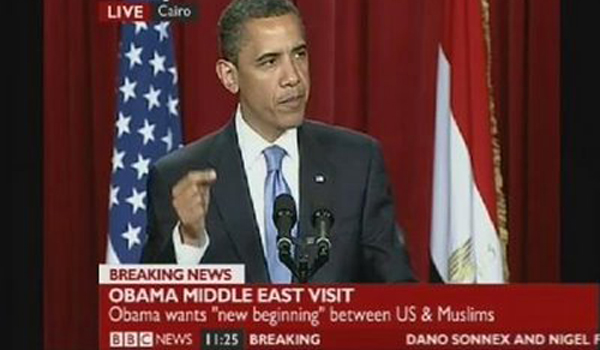 “The situation for the Palestinian people is intolerable. America will not turn our backs on the legitimate Palestinian aspiration for dignity, opportunity, and a state of their own.”
“The situation for the Palestinian people is intolerable. America will not turn our backs on the legitimate Palestinian aspiration for dignity, opportunity, and a state of their own.”
President Barack Obama | June 4, 2009 | Cairo Speech
U.S. policy supports efforts by the international community “to improve freedom of movement and access for Palestinians.”
Secretary of State Hillary Clinton | February 11, 2010 | Statement on the Middle East
History of Israeli Restriction of Palestinian movement
Control over Palestinian movement has been a feature of the conflict since 1948. Following the 1948 War, Israel incorporated laws that were used to restrict the rights of Palestinians inside Israel, most notably their freedom of movement which was controlled by permit requirements and curfews. In 1966, most of the restrictions imposed by Israel over Palestinian citizens of Israel under these regulations were lifted, but the regulations themselves remained in place.
After Israel’s occupation of the West Bank and Gaza in 1967, those regulations were incorporated into the military laws used to administer the occupied Palestinian territory. From 1967 to 1972, the occupied Palestinian territory was declared a closed military area by the Israeli military and many freedoms including the freedom of movement by residents were severely limited. In 1972 the Israeli military issued a general exit order which allowed Palestinian to enter Israel from the West Bank and Gaza during daylight hours with few limitations. During this period Palestinians could also travel with relative freedom between the West Bank and Gaza.
Some limits were imposed on the general exit permit during the First Intifada (1987-1993). (Intifada is Arabic for “shaking off;” the term used for two Palestinian uprisings in resistance to the Israeli occupation). Following the start of the first Iraq war in 1991, the general exit permit was revoked and a general closure was declared over the occupied Palestinian territory.
This was when Israel started requiring that all Palestinians acquire military issued permits if they wanted to enter Israel or move between the West Bank, East Jerusalem, and Gaza. This permit regime was formalized as a part of the Oslo Accords in the early 1990s. Today, Palestinian movement into and out of Israel and between the different parts of the occupied Palestinian territory remains restricted to those Palestinians who have received travel permits from the Israeli military.
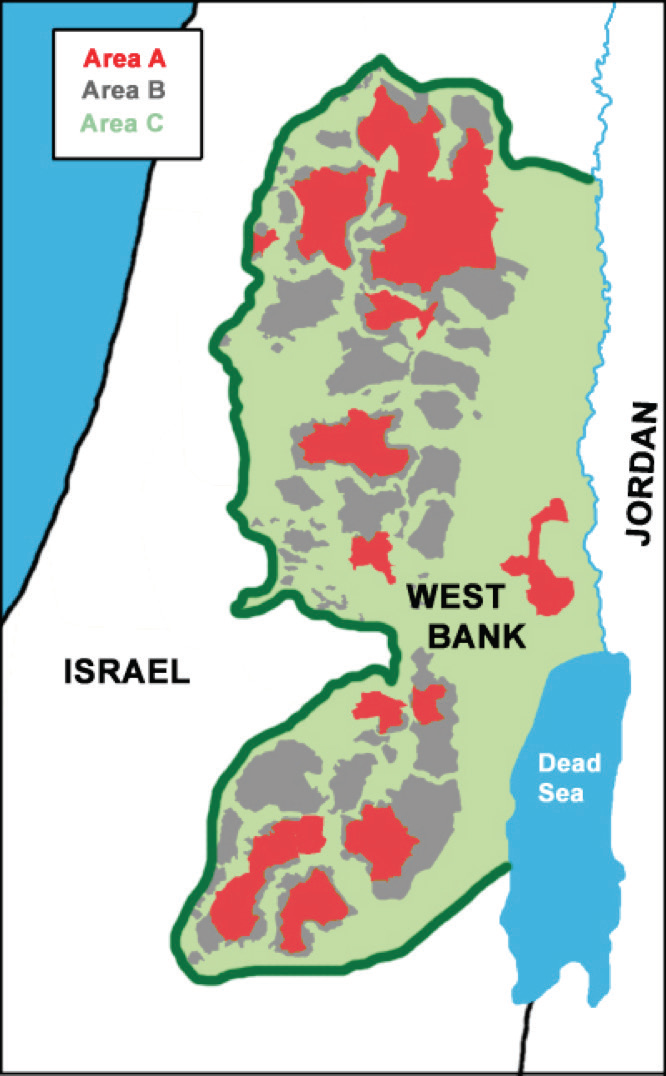 The Oslo Accords also resulted in new limitations on movement within the occupied Palestinian territory. The West Bank was divided into three administrative areas (A,B, and C):
The Oslo Accords also resulted in new limitations on movement within the occupied Palestinian territory. The West Bank was divided into three administrative areas (A,B, and C):
• Area A makes up 17% of the West Bank and is under full Palestinian control. Even before the start of the Second Intifada in September 2000 this division resulted in the imposition of movement restrictions between communities and between administrative areas inside the West Bank which were enforced through the imposition of mobile checkpoints.
• Area B, 22% of the West Bank, is under the full administrative control of the Palestinian Authority but under the military control of Israel.
• Area C, 61% of the West Bank, is under the full control of Israel through the Civil (Military) Administration in the West Bank.
After the start of the Second Intifada in 2000, Israel intensified the general closure over the occupied Palestinian territory, more closely controlling travel by Palestinians and formalizing an internal system of movement restrictions through permanent checkpoints, roadblocks, gates, closed roads, barriers, and the Wall.
Restrictions in place over Gaza were tightened in 2005 when Israel unilaterally withdrew its settlers and redeployed its troops from Gaza. Following the redeployment, Israel placed new and increased restrictions over the movement of people and goods into and out of Gaza. These restrictions were further tightened in 2006 after Hamas won the Palestinian parliamentary elections ,and then tightened again in 2007, when Gaza was placed under siege (or blockade) following the Hamas-Fatah factional split.
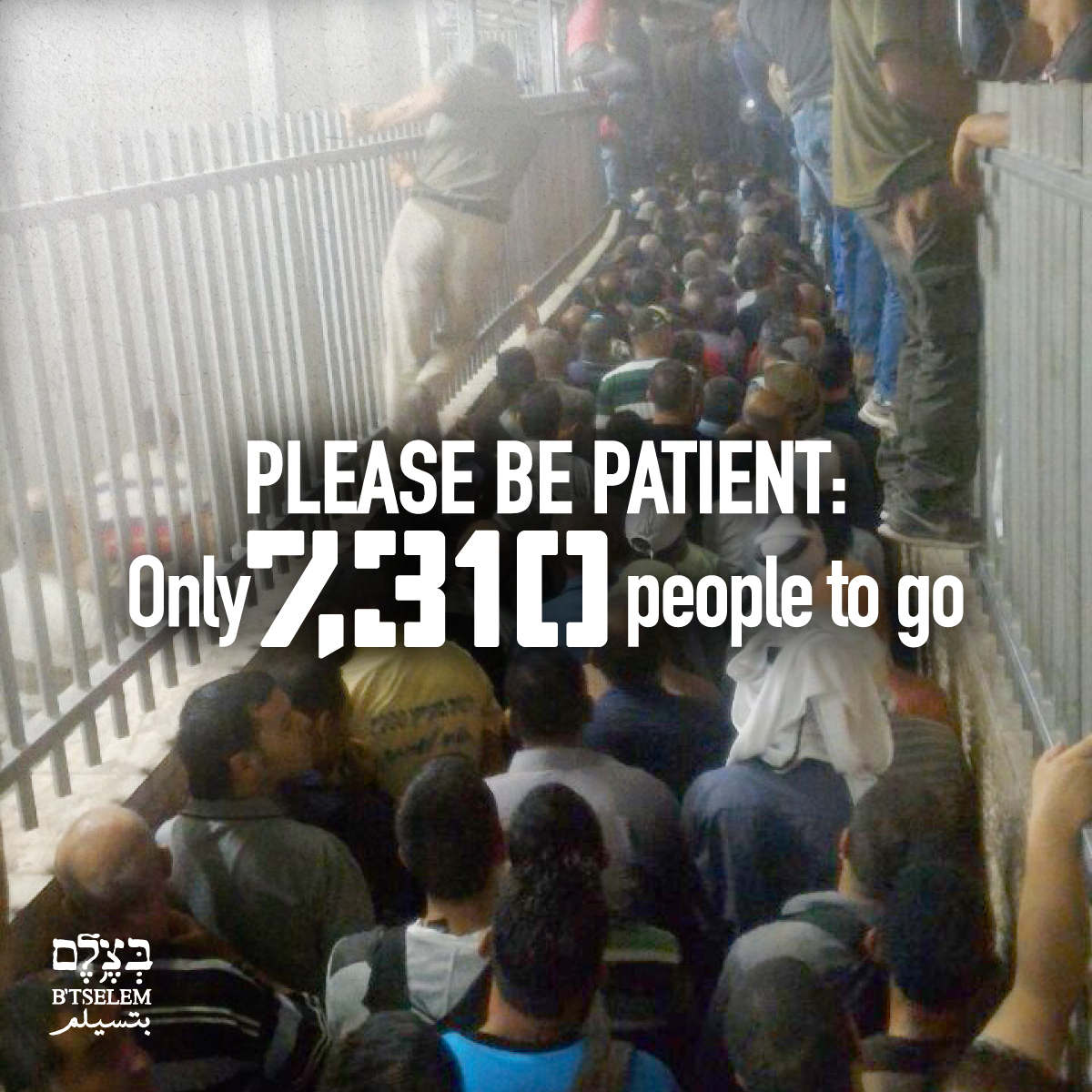 Checkpoints, Roadblocks and Barriers
Checkpoints, Roadblocks and Barriers
Checkpoints, roadblocks and other physical barriers are a constant reality of Palestinian life, especially in the West Bank. The vast majority of these obstacles are not on the border between Israel and the Palestinian territories, so they are not for the security of Israel. They are placed throughout the West Bank, isolating Palestinian communities from one another and making a normal life for Palestinians impossible.
Palestinians suffer from restricted access to essentials such as hospitals, jobs, schools, family members, farmland and their own homes. Trips that normally would take a few minutes can take hours due to waits at checkpoints, and extremely long detours due to roadblocks, the Separation Wall, and the segregated highway system that Palestinians are not allowed to use.
• The West Bank is a region approximately the size of the state of Delaware, the second smallest state in the U.S. There are hundreds of checkpoints, road blocks and other barriers for Palestinians through the West Bank.
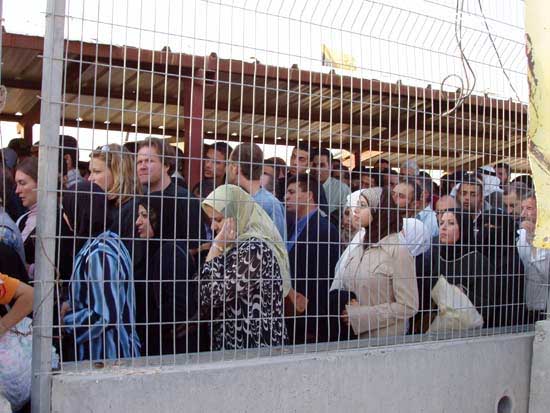 • Routinely, Palestinians wait hours to pass through checkpoints in order to carry out daily activities like visiting family and friends, getting to work, school, or the hospital.
• Routinely, Palestinians wait hours to pass through checkpoints in order to carry out daily activities like visiting family and friends, getting to work, school, or the hospital.
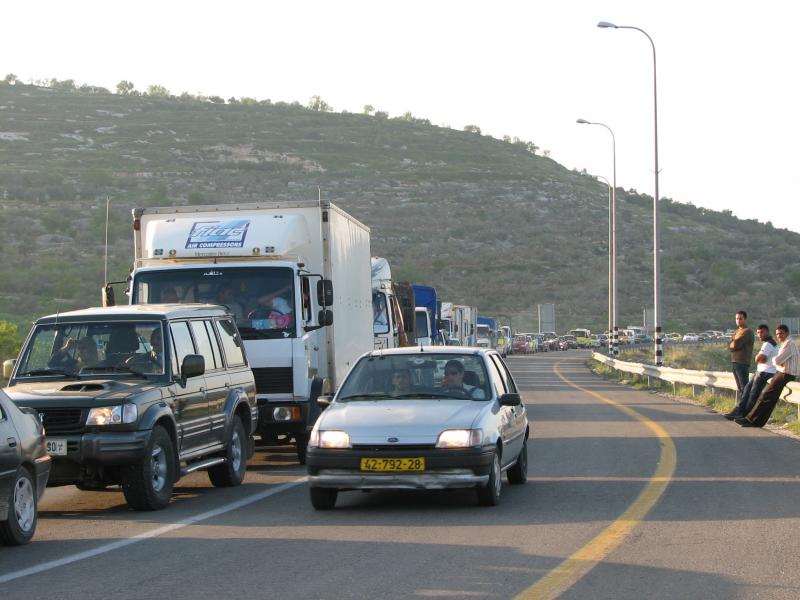
• 74% of the main routes in the West Bank are controlled by checkpoints or blocked entirely to Palestinian traffic. Most major highways in the West Bank are reserved for Israeli use only and are prohibited to Palestinians.
• Palestinians are required to obtain special permits from the Israeli military authorities to access the city of Jerusalem.
[It should be noted that Israel unilaterally expanded what it considers the municipal borders of Jerusalem, after occupying East Jerusalem during the war of 1967. Today East Jerusalem is still recognized to be occupied territory – not part of the State of Israel – by the international community.]
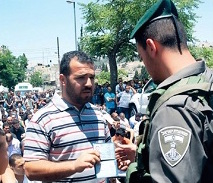 • Palestinian men aged 16-35 are often prohibited from moving through the checkpoints or getting permits. This prohibition implies that all young Palestinian men are a security threat, effectively imposing collective punishment on them. This restriction creates great hardship for those who need access to work, schools, family members, hospitals and more within the area of Jerusalem.
• Palestinian men aged 16-35 are often prohibited from moving through the checkpoints or getting permits. This prohibition implies that all young Palestinian men are a security threat, effectively imposing collective punishment on them. This restriction creates great hardship for those who need access to work, schools, family members, hospitals and more within the area of Jerusalem.
• In 1993, the Oslo Accord signed between the Palestinian Authority and the Government of Israel provided that “the movement of people and vehicles will be free and normal and shall not need to be effected through checkpoints and roadblocks.”
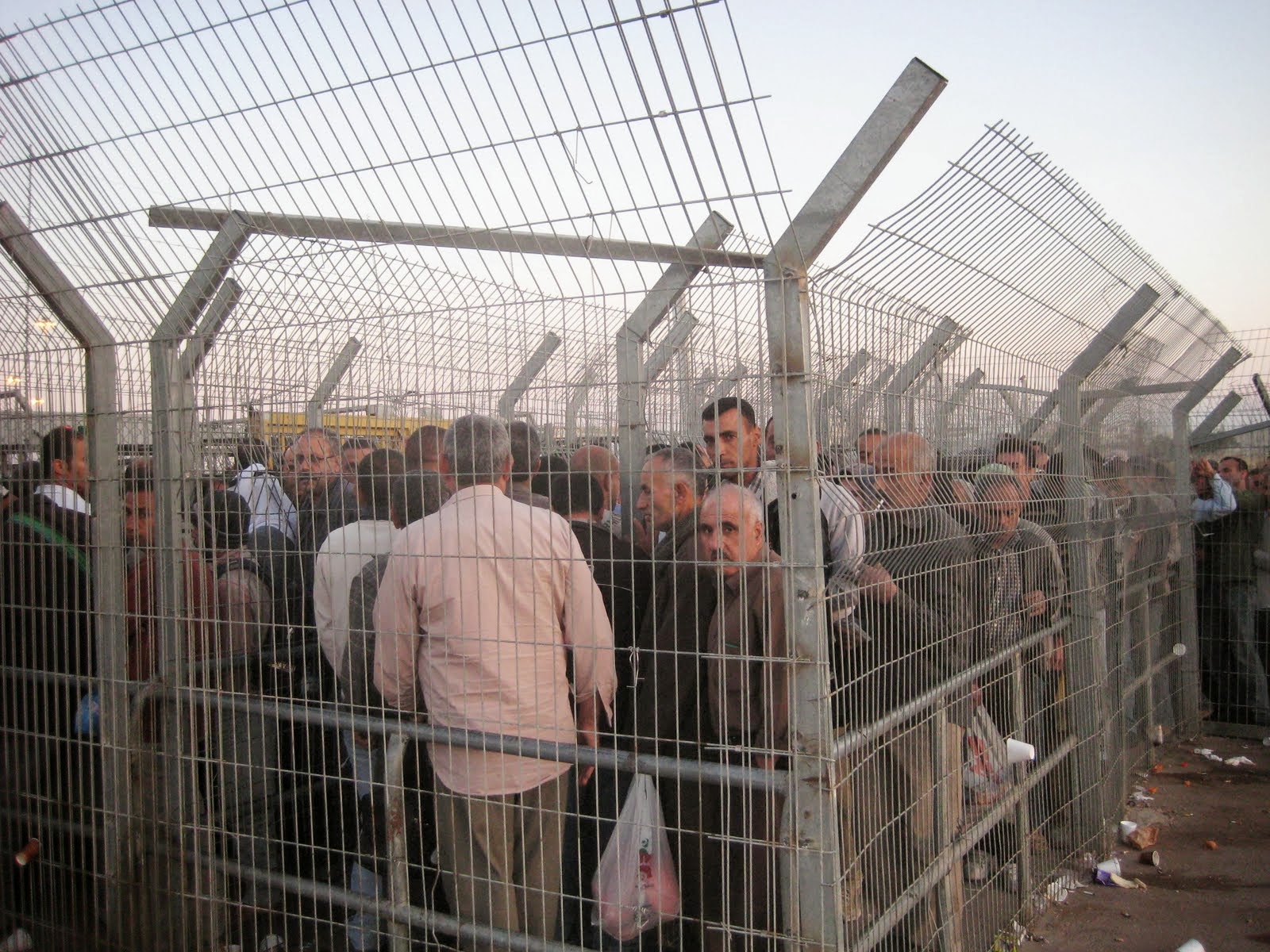
In summary: control of Palestinian movement has been a feature of Israel’s occupation of the Palestinian territory since its inception in 1967. In recent years the draconian system of movement controls used by Israel in the occupied Palestinian territory has become increasingly institutionalized and restrictive. The permit system put in place in the early 1990s requires that all Palestinians obtain military issued permits to move between the West Bank, Gaza, and East Jerusalem or to travel abroad . Israel also controls Palestinians’ daily movement within the occupied territory by a permanent system of roadblocks, gates, checkpoints, the Wall and other obstacles to movement in the West Bank (including East Jerusalem) and the Gaza siege.
Taken together, all of these factors severely limit Palestinian access to basic resources including land and water and essential services. They perpetuate a system of segregation and inequality between Palestinians and Israelis. Understanding how Palestinian’s freedom of movement is restricted is crucial to understanding the severe impact of Israel’s occupation on average Palestinians.
Freedom of Movement for Jerusalem Residents
After occupying East Jerusalem in 1967, Israel annexed the city to itself. This annexation has not been recognized or accepted by the international community, which continues to view East Jerusalem as part of the occupied Palestinian territory. Palestinian residents of Jerusalem refused to accept the annexation of Jerusalem and therefore did not take full Israeli citizenship. Instead, Palestinian Jerusalemites are considered “Permanent Residents” of Jerusalem. However, their status as residents of the city is anything but permanent.
Since 1967, over 14,000 Palestinians have had their residency rights in the city revoked. According to Israeli law the residency right of Palestinian Jerusalemites can be revoked if they leave Israel for a period of 7 years, if they gain permanent residency status in another country, if they gain citizenship status in another country, if they are declared a threat to national security, or if their center of life (job, home, etc.) as defined by the Israeli government is not in the city. Students studying abroad, individuals who leave Israel to pursue work opportunities, and Jerusalemites who gain employment in the West Bank have all had their Permanent Resident status revoked. Losing Permanent Resident status means losing their right to visit or live in Jerusalem. These same restrictions do not apply to Jewish Israeli residents of Jerusalem.
 In 2002, Israel froze the family reunification process through which Palestinian residents of the West Bank and Gaza could gain Jerusalem residency rights if they married a Palestinian from Jerusalem. The Military Order that put in place this freeze was transformed into “The Nationality and Entry into Israeli Law” in 2003. This law makes it nearly impossible for Palestinians from the occupied Palestinian territory who are the spouses of Palestinian Jerusalemites (or of Palestinian-Israelis) to gain citizenship. The effect of this law is that Palestinians from Jerusalem who marry Palestinians from the West Bank or Gaza must move out of Jerusalem if they wish to live with their spouse, but if they move they risk losing their Jerusalem residency rights.
In 2002, Israel froze the family reunification process through which Palestinian residents of the West Bank and Gaza could gain Jerusalem residency rights if they married a Palestinian from Jerusalem. The Military Order that put in place this freeze was transformed into “The Nationality and Entry into Israeli Law” in 2003. This law makes it nearly impossible for Palestinians from the occupied Palestinian territory who are the spouses of Palestinian Jerusalemites (or of Palestinian-Israelis) to gain citizenship. The effect of this law is that Palestinians from Jerusalem who marry Palestinians from the West Bank or Gaza must move out of Jerusalem if they wish to live with their spouse, but if they move they risk losing their Jerusalem residency rights.
Therefore, while Palestinian residents of Jerusalem can travel more freely than Palestinians from other parts of the occupied Palestinian territory most of the time, their ability to change their place of residence and to leave Jerusalem for an extended period is severely limited.
The Separation Wall
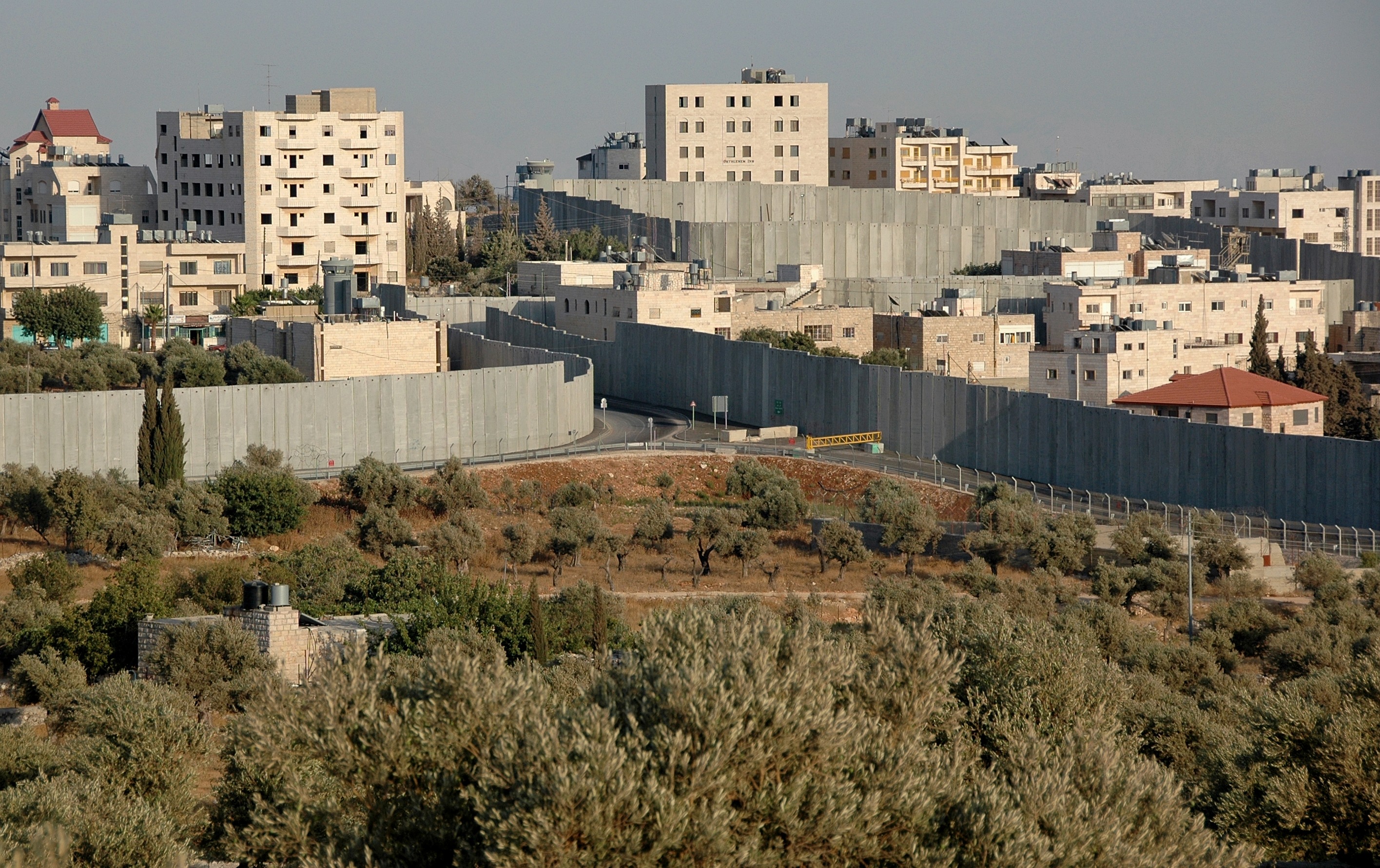
Since June 2002, Israel has been building a wall inside the West Bank, which it claims is for security reasons. That might be plausible and legal, if the wall were being build on the recognized borders of Israel (the borders established by the Armistices of 1949, also known as the Green Line). However, because of the Wall’s location – 85% of the route of the Wall is within the occupied territory – the Separation Wall is a violation of international law and human rights.
When the Wall is completed, 9.5% of all West Bank land will be located on the western Side of the Wall and thus will be effectively annexed to Israel. The wall confiscates that Palestinian land in the West Bank, destroys property and permanently alters the physical landscape of the occupied territories. Through home demolition, land confiscation, the uprooting of crops, the isolation of communities and the separation of people from vital resources, the Separation Wall causes great hardship and severe violations of Palestinians’ rights.
In 2004, the International Court of Justice declared the Separation Wall to be “contrary to international law. Israel is under obligation to dismantle forthwith the structure [and] make reparation for all damage caused…”
 Included in the area cut off by the Separation Wall (also called the Security Barrier, Separation Fence and by other names) are dozens of illegal Israeli settlements and 33 Palestinian communities. Those Palestinian communities, with tens of thousands of residents, are completely isolated from other areas of the West Bank. All residents of these communities over the age of 12 must get residency permits from the Israeli military in order to remain in their homes. Residents can only enter and leave their communities through gates in the Wall that are controlled by the Israeli military and are not opened regularly. Because these are small and rural communities, most of them do not have their own hospitals, schools, clinics, and stores and therefore rely on other nearby towns for these services. The Wall severely limits their access to these vital services.
Included in the area cut off by the Separation Wall (also called the Security Barrier, Separation Fence and by other names) are dozens of illegal Israeli settlements and 33 Palestinian communities. Those Palestinian communities, with tens of thousands of residents, are completely isolated from other areas of the West Bank. All residents of these communities over the age of 12 must get residency permits from the Israeli military in order to remain in their homes. Residents can only enter and leave their communities through gates in the Wall that are controlled by the Israeli military and are not opened regularly. Because these are small and rural communities, most of them do not have their own hospitals, schools, clinics, and stores and therefore rely on other nearby towns for these services. The Wall severely limits their access to these vital services.
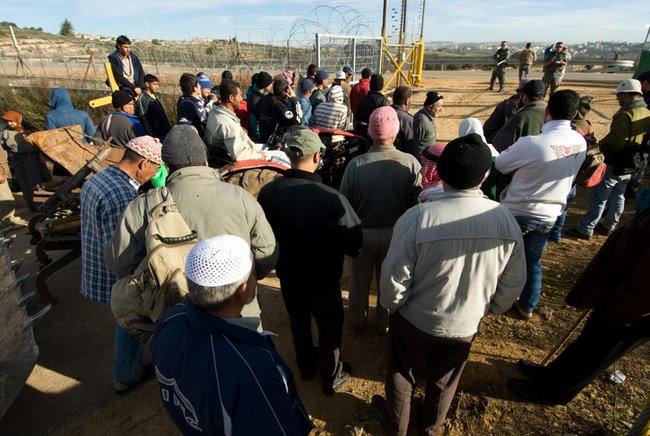
Agricultural land belonging to more than 150 West Bank communities, home to approximately 200,000 people, has also been annexed to Israel as a result of the Wall. In theory, this land can be accessed through 73 gates that have been built in the Wall. However, 70% of the gates in the Wall are only open for a few weeks each year, during the annual olive harvest. Only 11 gates open on a daily basis and 10 more open on a weekly basis.
Even if these gates were open more regularly, access to land that has been cut off would remain restricted by the permit requirements. All of the land in these areas was declared a closed military zone in 2003, and all people wishing to enter – including the land owners – must obtain special permits. Without the proper permit from the Israeli military, the farmers cannot get access to their own land. According to OCHA, only 40% of requests for those permits are granted, which has decreased farming in these areas by over 80 percent.
The Blockade of Gaza
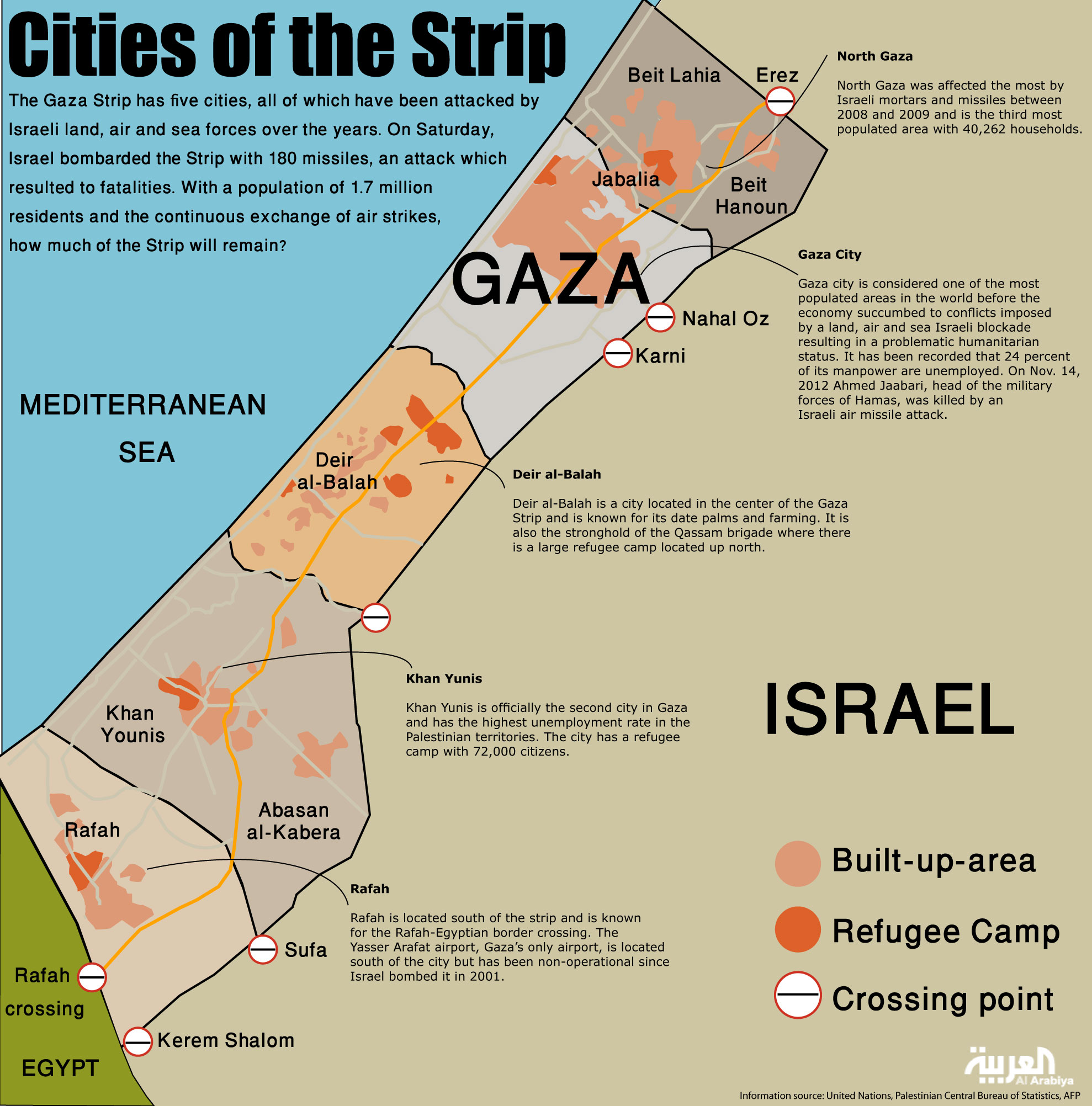
Gaza is an area 25 miles long and from 4 to 7.5 miles wide; as of October 2016, it is home to 2 million Palestinians, roughly a third of whom are refugees. Gaza’s borders are controlled primarily by Israel, with the small southern border controlled by Egypt. [It should be noted, that U.S. aid to Egypt is among the largest U.S. international aid packages; Egypt, not coincidentally, complies with Israeli policy regarding the blockade of Gaza.] Israel controls Gaza’s airspace and territorial waters. Since 2007, Israel has imposed an almost total blockade on the movement of people and goods in or out of Gaza.
• Since 1988, Israel has prevented Palestinians from traveling between Gaza and the West Bank.
• As of August 2009, 80% of Gaza residents lived in poverty and 60% were unemployed.
• In 2007, 18.5% of patients seeking emergency medical treatment outside of Gaza were refused permits to leave.
• In 1994, Israel built a wall around Gaza and designated a “buffer zone” inside it, which is • inaccessible to Palestinians. This buffer zone includes at least 30% of the arable land in Gaza.
• Due to the Israeli blockade, the United Nations reports that 70-80% of Gazans are dependent on humanitarian aid for survival.
The movement of both goods and people into and out of Gaza was strictly limited in 2005 when Israel unilaterally withdrew its settlers and redeployed its troops from Gaza. In that year Israel severely cut back the number of exit permits that it gave to Palestinians wishing to leave Gaza. These restrictions were strengthened in 2006 after Hamas’ victory in that year’s parliamentary elections. After Hamas won that democratic election, Israel and the U.S. refused to honor those results and put in place sanctions against the Palestinian Authority, because it was then being led by Hamas. These sanctions included limitations on imports and exports for all of the occupied Palestinian territory, and withholding of essential funding.
The sanctions and the economic crisis they created were following by internal fighting in 2007 between Hamas and Fatah, the rival political party which had run the PA previously. As a result of that fighting, Hamas lost control of the West Bank to Fatah and had control of the Gaza Strip. Then the international sanctions against the Palestinian Authority were lifted in the West Bank, but strengthened in Gaza. These strengthened sanctions effectively placed a blockade over Gaza, severely limiting exports and imports and banning nearly all travel by residents of Gaza.
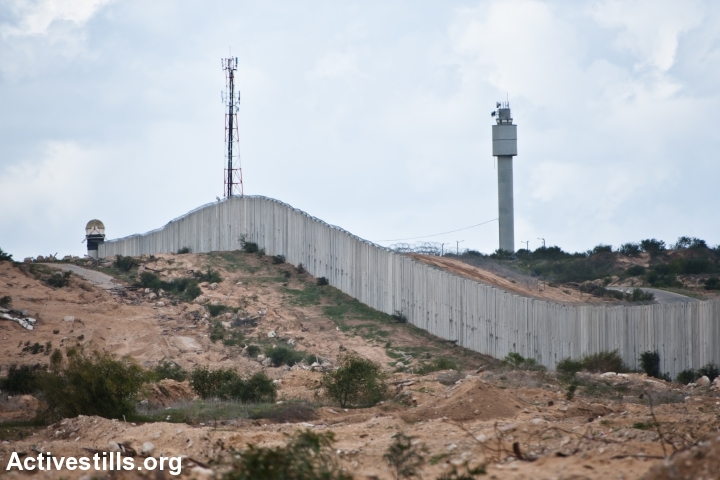
Between 2007 and 2010, even basic necessities such as cooking gas, water filtration equipment, toilet paper, tooth paste, clothes, noodles, candy, and spices were blocked from entering Gaza. In 2010, the Israeli government announced an “easing” of the blockade and allowed for limited increases in imports such as clothing and food. However, severe restrictions on the import of many goods including the raw materials necessary for industrial production, construction materials, medical supplies, fuel, and many consumer goods were never lifted, and there was no easing on the restrictions imposed over exports from Gaza.
The movement of people into and out of Gaza is also severely restricted. Prior to the outbreak of the Second Intifada in the early 2000’s, approximately 26,000 people were allowed to leave Gaza each day via the Erez crossing. During the first half of 2013, only 200 people on average crossed Erez each day.
• Students are denied exit to study abroad.
• Patients needing medical treatment not available in Gaza are delayed or blocked from reaching care.
• People with families in other parts of the occupied Palestinian territory are blocked from seeing their relatives.
• People wishing to leave to pursue work in other places are blocked from doing so.
Nearly all access to the outside world for the residents of Gaza is blocked.
ISRAEL’S RESTRICTED ACCESS AREA WITHIN GAZA
Movement inside Gaza is also restricted, in the “restricted access area” (often referred to as the Buffer Zone), an area along the wall Israel has been built between Gaza and Israel (not to be confused with the Separation Wall Israel is building inside the West Bank). In the restricted access area in Gaza, Palestinians can be shot on sight by the Israeli military.
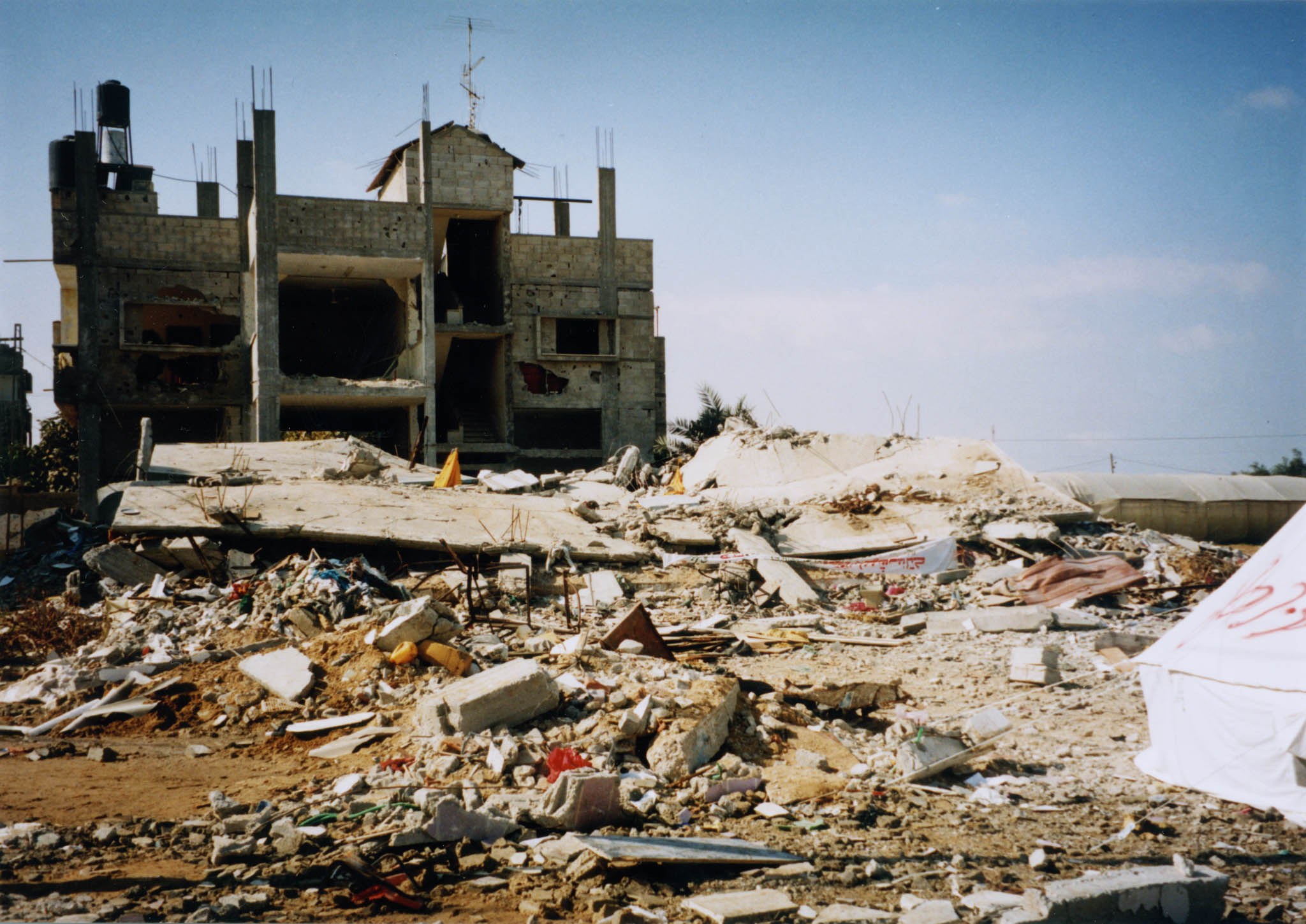
The restricted access area was first created during the Second Intifada, when Israel also began systematically demolishing homes and structures in areas near the Gaza borders. In May 2009, the Israeli military announced an expansion of the restricted access area, warning that anyone coming within 300 meters of the border could be shot. Additional homes and structures in this area were destroyed.
Israeli forces conduct regular raids as far as two kilometers into Gaza and constantly monitor all areas up to two kilometers inside Gaza. The land included in the restricted access area accounts for 17 percent of the total Gaza land area and includes 35 percent of Gaza’s agricultural land.
THE IMPACT OF THE BLOCKADE OF GAZA
The blockade has had a devastating impact on the Gaza population, affecting all aspects of life.
According to UN OCHA, as of June 2013:
• Less than 200 people per day were allowed out of Gaza via Israel in the first half of 2013.
• Less than one truckload of goods per day were allowed out of Gaza during the first half of 2013.
• 57 percent of Gaza households are food insecure, and approximately 80 percent receive some form of food assistance.
• 35.5 percent of those able and willing to work are unemployed – one of the highest unemployment rates in the world.
• Due to fuel shortages, there are power outages for up to 12 hours per day in most areas of Gaza. [In 2017, these power outages have increased to up to 20 hours per day.]
• Only 25 percent of households in Gaza receive running water every day, and then only for a few hours.
• Over 90 percent of the water extracted from the Gaza aquifer is unsafe for human consumption, while needed filtration equipment cannot be imported to Gaza.
• Nearly 90 million liters of untreated or partially treated sewage is dumped into the sea off of Gaza every day, while equipment needed to build new or maintain existing treatment facilities are banned from entering Gaza.

The terrible human suffering caused by the blockade of Gaza should not be viewed as a humanitarian crisis that can be solved through providing international aid, though of course that aid is desperately needed. Rather, the current situation in Gaza is a political crisis that can only be resolved through political action. All of the impacts outlined above are the direct result of Israeli actions and policies, and ending the crisis in Gaza therefore requires ending the blockade and Israel’s continued occupation of the Palestinian territory, which are at the root of the crisis.
See more on our page about Gaza.
![]()
Resources
PRINT RESOURCES
AFSC – PDF: Freedom of Movement – 2 pp.
AFSC – PDF: Restricted Movement in the Occupied Palestinian Territory – 8 pp.
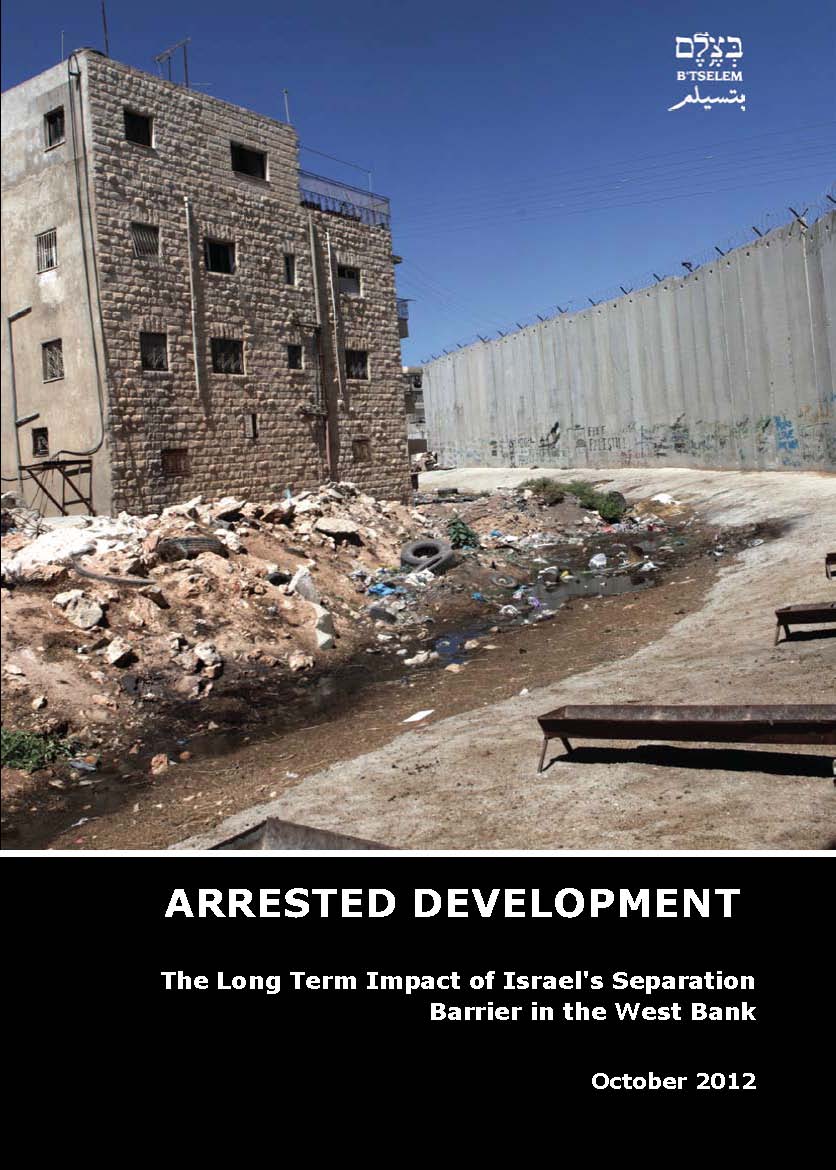 B’Tselem
B’Tselem
Web page: Background on the restriction of movement
http://www.btselem.org/freedom_of_movement
Web page: Checkpoints, Physical Obstructions, and Forbidden Roads, includes listing of checkpoints.
http://www.btselem.org/freedom_of_movement/checkpoints_and_forbidden_roads
Web page: The Separation Barrier
http://www.btselem.org/separation_barrier
Web page: Closure
http://www.btselem.org/freedom_of_movement/closure
Figures on closure days:
http://www.btselem.org/freedom_of_movement/siege_figures
Web page: Siege
http://www.btselem.org/freedom_of_movement/siege
Web page: Alternative roads for Palestinians
http://www.btselem.org/freedom_of_movement/alternative_roads_for_palestinians
Web page: Splitting the West Bank
http://www.btselem.org/freedom_of_movement/splitting_of_the_west_bank
Web page: Impact on the economy of restrictions of freedom of movement
http://www.btselem.org/freedom_of_movement/economy
Web page: Infringement on the right to medical treatment
http://www.btselem.org/medical_treatment
PDF: The Invisible Walls of Occupation: Burqah, Ramallah District, A case study – 4 pp.
PDF: So Near and Yet So Far: Implications of Israeli-Imposed Seclusion of Gaza Strip on Palestinians’ Right to Family Life
Joint report by Hamoked and B’Tselem
Summary Full report
Web page: Comics inspired by testimonials in So Near and Yet So Far
http://www.btselem.org/publications/so_near_and_yet_so_far
PDF: Arrested Development: The Long Term Impact of the Separation Barrier
Summary Full report
Web page: Interactive presentation on Arrested Development
http://www.btselem.org/publications/arrested_development/app
Updates related to Restriction of Movement
http://www.btselem.org/ota?tid=51
Personal testimonies related to Restriction of Movement
http://www.btselem.org/testimonies?tid=51
CPT – PDF: CPT_A Method to the Madness – 1pg.
EAPPI – PDF: Bethlehem Checkpoint 300: Humanitarian situation deteriorates – 2 pp.
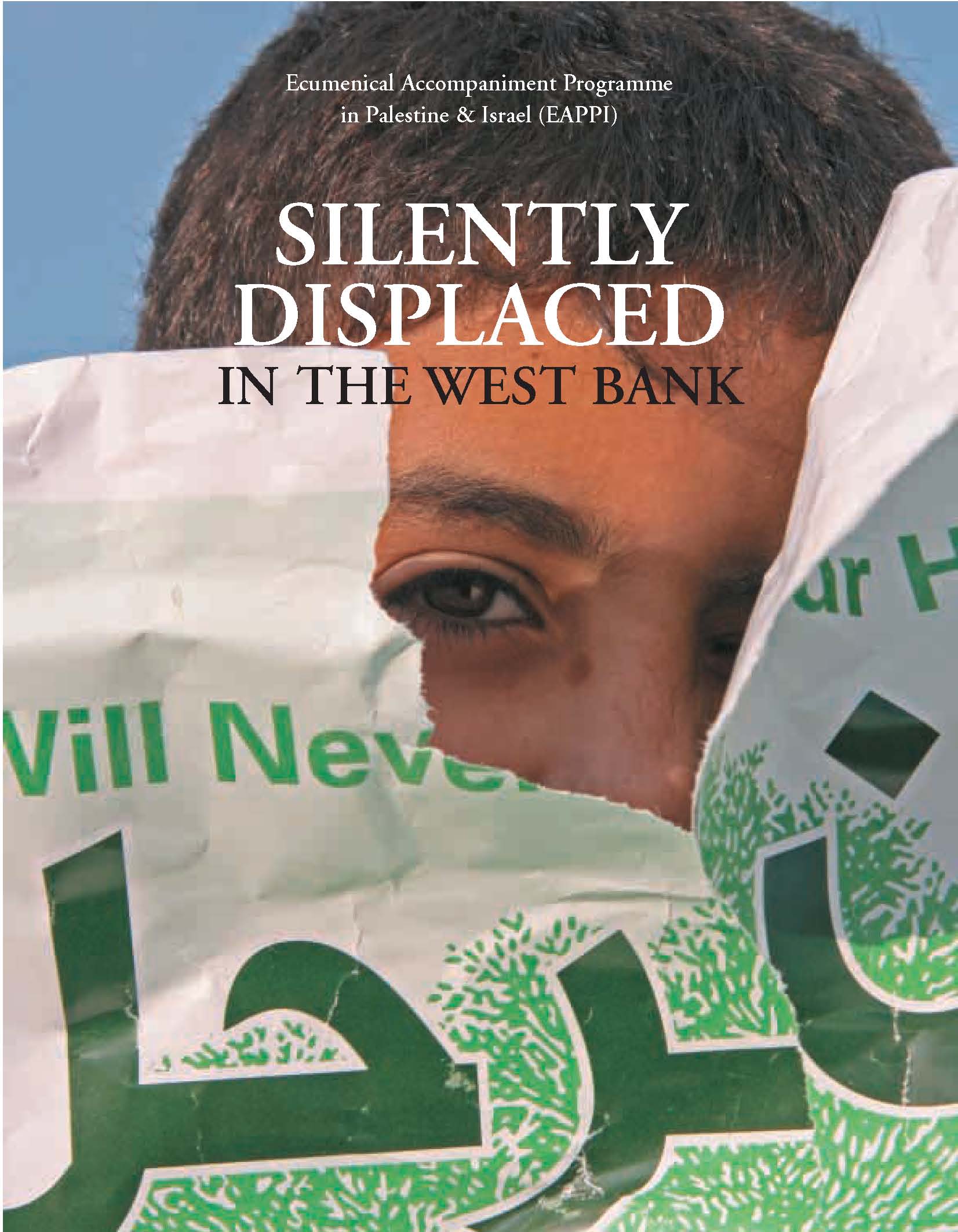 EAPPI – PDF: Silently Displaced in the West Bank – 96 pp.
EAPPI – PDF: Silently Displaced in the West Bank – 96 pp.
IPMN – PDF: Steadfast Hope Fact sheet, The Matrix Of Control – 3 pp.
Machsom Watch, a volunteer organization of Israeli women who monitor the Israeli checkpoints.
Website: https://machsomwatch.org/en
NAD – PDF: Dying Village of Nabi Samwel – 2 pp.
NAD – PDF: Palestinian Movement Restrictions Highlight Israeli Apartheid – 2pp
UMHLTF – PDF: Introduction to the Israeli Occupation – 4pp.
Color Black & White
UMKR – PDF: Why Boycott the Settlements? – 4pp
PHOTOS
B’Tselem – Web page: Photos related to Restriction of Movement
http://www.btselem.org/photos/51
EAPPI – Web page: Collection of photos and notes that depict Palestinian life without essential freedom of movement.
http://eappi.org/en/resources/photos/checkpoints-agricultural-gates
VIDEOS
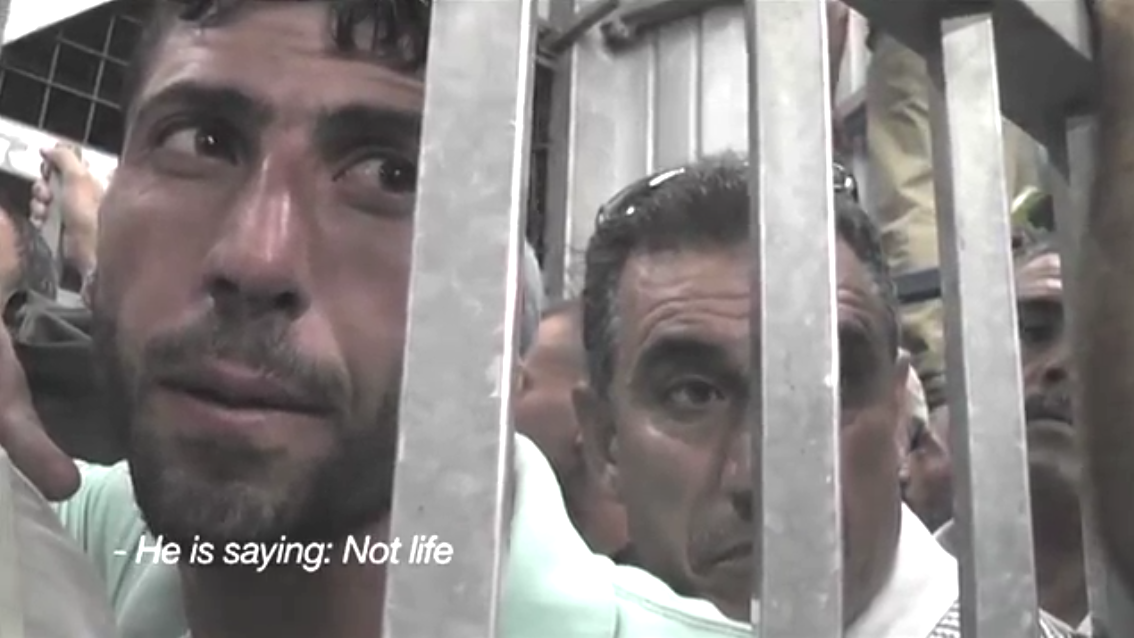 B’Tselem – Web page: Videos related to Restriction of Movement
B’Tselem – Web page: Videos related to Restriction of Movement
http://www.btselem.org/video/search/51
UCC – A Ride Through a Checkpoint (5mins, 45 sec)
Vividly shows the daily experience of Palestinians trying to get to work in the morning.
See more videos on the Middle East Resources page of the UCC; scroll down the page for the videos.
http://www.globalministries.org/mee_resources_index



